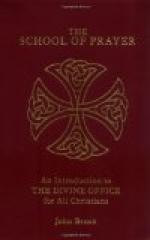We may sum up, then, all that has been said in this long section by stating that from Apostolic times there was public prayer, thrice daily. The Jewish converts, having the psalms committed to memory needed not, nor could they have in those bookless days, a psalter script. In the third century, morning, evening, and night offices are mentioned. Compline was in existence in the time of St. Benedict. “From the seventh century onwards, ecclesiastical writers, papal decrees and conciliar decrees recognise the eight parts of the office, which we have seen took shape during the sixth century, and regard their recitation by priests and monks as enjoined by positive law. During this period, or at least at its commencement, Lauds and Vespers alone had a clearly defined structure and followed a definite arrangement. As far as we can see, St. Gregory arranged the little hours for Sunday only, and their arrangement for week days was left to the care of the bishops and metropolitans, or even of abbots. This was also the case, in many instances, with regard to Matins, for the number of psalms to be recited thereat was not definitely fixed. As regards the little hours—Prime, Terce, Sext, None and Compline—the freedom of the competent ecclesiastical authorities was as yet unconfined by canonical restrictions. Chrodegang (766) was first to follow the usages of the Benedictines of the Roman Basilica, in prescribing for secular clergy the celebration at Prime of the officium Capituli (i.e., the reunion in the chapter for reading the rule or, on certain days, the writings and homilies of the Fathers). The rest of the chapter—i.e., all that follows the confiteor in Prime as a preparation for the work of the day, seems to have been composed in the ninth century.... Under Charlemagne and his successors variations in the canonical hours completely disappeared” (Baudot, op. cit., pp. 63-65).
On this foundation was built up the Office, to which additions were made, and of which reforms were effected, up to our own time.
“For us, traditional liturgy is represented by the Roman Breviary of Urban VIII., a book which constitutes for us a Vulgate of the Roman Office.... The thing which renders this Vulgate of 1632 precious to us is that, thanks to the wisdom of Paul IV., Pius V., and Clement VIII., the differences between it and the Breviary of the Roman Curia of the thirteenth century are mere differences of detail: the substantial identity of the two is beyond dispute. The Breviary of Urban VIII. is the lineal descendant of the Breviary of Innocent III. And the latter in its turn is the legitimate descendant of the Roman canonical Office, as it was celebrated in the basilica of St. Peter at the end of the eighth century, such as it had gradually come to be in the course of the seventh and eighth centuries, a genuinely Roman combination of various elements, some of them Roman and some not, but of which some, at all events, go back to the very beginnings of the Catholic religion” (Battifol, op. cit., p. 353).




